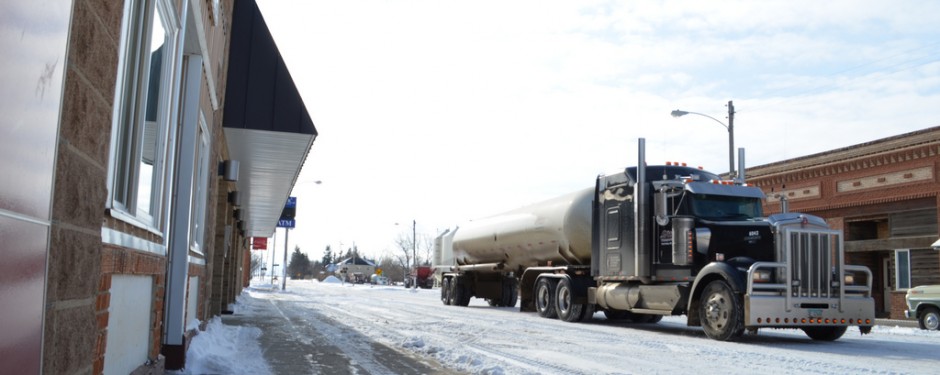
His trip to the oil field was a bust. So about two hours before sunset, John, a ruddy-faced man in his mid-fifties, walked into a Moorhead homeless shelter looking for a place to sleep. “I would love to get one of them oil field jobs. Them guys make 25 dollars an hour,” he says.
John — he didn’t want me to use his last name — is a barrel-chested man with a walrus moustache. A native of Richmond, Virginia, John arrived in North Dakota about a year ago for one simple reason. “Because the rest of the country the employment rate is terrible,” he says. “They say 10 percent, but I think it’s a lot higher than that. Plus with my age — I’m in my middle fifties — I mean ‘C’mon boss, you gonna hire someone to roof that’s eighteen or some 55-year-old guy?’”
Last summer, he worked the sugar beet harvest and a few other odd jobs before recently heading west to strike it rich. Due to a couple of drunk driving convictions, John doesn’t drive. But he had good luck hitchhiking, getting from Grand Forks to Williston in two rides. Once in Williston, John started making the rounds. And while he didn’t expect to land a job right away, he had hope.
After Williston, he worked his way to Dickinson, applying for more jobs there. In total, John says he completed 24 applications at drilling companies, restaurants, stores — all sorts of places. One company he’d really, really love to work for is Halliburton, an oil company based in Houston.
“I mean if Halliburton called me tomorrow, I’d be there,” he says.
Halliburton has a big, big presence in western North Dakota. People in Williston see Halliburton’s white trucks on the road all the time. “Every time I saw one go by, I just saw a little prayer inside my head, you know,” John says.
John is far from the only one to arrive in the oil patch looking for work. “The word is out nationwide that there are jobs in North Dakota,” says John Roberts, a former Methodist minister who now works at Churches United, a homeless shelter in Moorhead. “So people travel here. They arrive here with no funds. They arrive here homeless. And so they seek out the shelters as a place to stay as a launching pad to finding jobs and moving on to the next better part of their lives.”
Churches United has been busier than usual this winter and spring. Its 65 beds are consistently filled. So are the other 210 beds in other Fargo-Moorhead homeless shelters. As a result, the chapel has been turned into a place to sleep for about 10 people every night.
“We’re not complaining, however,” Roberts says. “Our mission is to provide shelter and so that’s what we’re doing. The need for shelter beds among the homeless in our community has increased.”
On this night, Churches United is housing at least one other oil field job seeker: John Hales of St. Louis. He spent a couple of weeks in Williston looking for work. Despite what he says is a spotless work record, Hales came up empty. To save money, Hales slept in his car during his oil patch job search.
“Funny waking up in [a Williston] parking lot,” Hales says. “The first thing you see is exhaust from probably 25 other cars in the parking lot from other folks sleeping in their cars.”
Once he arrived in Fargo/Moorhead, Hales found Churches United and a bed. That transition was surprisingly difficult. “I got back here and I got in a bed and for the first two nights the bed was uncomfortable because my body I adjusted to the seat,” he says. “My back wasn’t used to laying flat.”
In Killdeer, North Dakota, a small town near Dickinson, Robbie Reid is humping his backpack down Main Street. “I call it my mountain backpack, like the mountain climbers wear,” he says. “I’ve got my sleeping bag in there. I sleep on the street, not on the street. But I find me a patch of woods or an abandoned building or something. I’ve just been winging it, you know.”
The 48-year-old Floridian arrived in the oil patch for the same reason as thousands of other men: He came to work. “I found a job washing dishes 10 days ago at a truck stop, but I just got laid off because the boss said they had too many people on the payroll,” Reid says.
One night earlier, Reid slept in an unoccupied building at a construction site. According to a 2011 survey by the North Dakota Coalition for the Homeless, about 40 percent of the state’s homeless population is like Reid — they arrived here from elsewhere. Most want to work. Reid noticed that a café in Killdeer had a “Help Wanted” sign posted. If that’s a full-time job, Reid says he’d be interested. If not, he plans to hitch a ride to Dickinson.
“I got Jesus in my life,” Reid says. ” I’m confident. I’ll find me something. I got my food stamps while I was here. So I won’t starve to death. But I’ll find a job soon.”
That may be the easy part. Finding a place to sleep — a permanent home in the overpopulated oil patch — that’s the tough part. I asked Reid if he expected to be sleeping outside all summer long.
“I honestly don’t know,” he says. “To answer your question, I don’t know.”
Leave a Reply
No related posts.
















